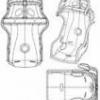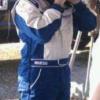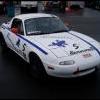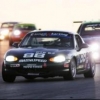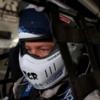
SCCA seat slider rules just changed again
#21

 Posted 02-25-2011 10:55 AM
Posted 02-25-2011 10:55 AM

Pat



#22

 Posted 02-25-2011 11:07 AM
Posted 02-25-2011 11:07 AM

The back of the seat shall be firmly attached to the main rollhoop, or its cross bracing,
so as to provide aft and lateral support.
Edited to add snarky comment: Drill baby, drill!
Former driver

#23

 Posted 02-25-2011 11:52 AM
Posted 02-25-2011 11:52 AM

1. Side Brackets - Under the FIA 8855-1999 Seat Homologation, the specific seat is tested with the manufacturer's side bracket of choice. This does not require you to use the exact side bracket used for the FIA testing, but simply that you must use a fixing bracket of equal or greater strength to that of the side bracket tested under the FIA Homologation process. Some Manufacturers do indeed stamp the brand into the seat, like Racetech...Some do not! *IF* you decide to use an after market mounting bracket, the only thing you must consider is if they are as strong or stronger than the seat manufacturer's mounting brackets.
Side Bracket with Brand Stamped in plain sight...

Side Bracket properly mounting into our Toyota Yaris race car. Please note the adjustability, this seat is adjusted fully forward as my boss is a small guy, 5' 6" to be exact. It will take less than 10 minutes to remove the (4) side bracket bolts and (2)back mount bracket bolts, move the seat for a taller/larger driver and then reinstall all hardware. This isn't nearly as fast as a slider, but infinitely safer in the event of an impact while on the track!

2. Slider Assemblies - Sliders are the most unsafe and detrimental items you can install into your seat/harness safety system! No slider assembly ever put into a sled test could handle more than 4.5-5G's of lateral force (And this example is of the *best* slider assembly available). This basically makes a completely weak point in the safety system of your race car. Imagine in an impact of greater than 10G's, which isn't that great of an impact, the slider assemblies giving way while the rest of the safety controls are able to withstand immensely greater forces. You will remain strapped into your seat as it bounces around knocking you into the roll cage, dash, steering wheel, transmission tunnel, etc. because the harness is mounted to the car and isn't going to give way like the slider assembly did...Bottom line, there is no slider assembly that is FIA Homologated nor are any of them safe for use in an actual race car!
3. Back Mounting - There are a very diverse selection of seats that come from the manufacturer with proper back mounting provisions. Although the FIA 8855-1999 Homologation did not require back mounting during their testing, when Daimler Chrysler asked Racetech to develop a seat for a special project that would later be known as the Viper Competition Coupe (And subsequent Viper ACR-X) their requirements were that the seat *MUST* be able to handle 45G's of dynamic force on the test sled from all directions. This is where the development of the RT4009HRV/WHRV seat started. These seats come with a fully integrated back mounting system that increases the strength of the seat, but also allows the use of a back mount plate without ruining the structural integrity of the composite construction of the seat by slapping a carriage bolt through the shell with washers.
From the Viper project, Racetech also developed the ultra lightweight RT9119HR/WHR seats, which require the back mount system be used to meet the FIA 8855-1999 Homologation. This is simply because the seat is a full carbon/kevlar shell and made so lightweight (14.5lbs for the HR and 16.5lbs for the WHR).
Again, this is our Toyota Yaris race car equipped with the RT4009HRV Viper seat. You can see the back mount installed and properly secured to the roll cage harness loop. Again, since my boss is a little guy (from New Zealand to boot) the back mount is adjusted fully forward. This allows for full adjustability for taller/larger drivers.


4. FIA 8862-2009 Homologation - The newest enhanced seating standard that Racetech helped develop with the FIA changes a lot of what the 8855-1999 Homologation consisted of. Some of the highlights of the FIA 8862-2009 Homologation are as follows:
- 75G's of Quasi-Static Load Testing
- Side Brackets & Back Mount Brackets (If Equipped) are part of the FIA 8862-2009 Homologation for a given seat.
- 10 Year Seat Life (FIA 8855-1999 Seat Life is 5 Years). While the FIA 8862-2009 seats start at twice the price of current FIA 8855-1999 seats, they have twice the life, which makes the cost per year nearly equal, yet you get 3 times the safety in capabilities.
- Racetech has the back mounting system trademarked and patented so Racetech will be the *ONLY* seat manufacturer to have the back mounting provisions under the FIA 8862-2009 Homologation. This has one major advantage over a side mount only system. With the incorporation of the back mounting into our seats, this has allowed Racetech to meet the 75G load testing while creating seats that are literally HALF the weight of the other seats Homologated under the FIA 8862-2009 standard.
Now, as the FIA 8862-2009 Homologation begins to be implemented, this changes a lot, you *MUST* use the mounting brackets used for the FIA testing, one bonus is that now the brackets are all to be included with the seats, not a separate item you must purchase atop the seat. No one in the US is yet talking about implementation of the FIA 8862-2009 Homologation, but abroad, the implementation has already begun.
RT4129HRW/WTHR seats, which is the only non-full carbon/kevlar shelled seats to pass the FIA 8862-2009 Homologation to this point.

Back Mounting provisions built into ALL of Racetech's 8862-2009 Homologated seats. The RT4009HRV/WHRV seats have very similar back mounting provisions.

FIA 8862-2009 Homologation label on seat including the Intellectual Property Rights label. All serial number information is matched to each seat for traceability and confirmation that all parts of the seat assembly are matched!

Each side mounting bracket as well as the back mount bracket of ALL FIA 8862-2009 Homologated seats have the same FIA Homologation label as the seat shell itself.

This video is is from last season's Australian V8 Supercar Series where Fabian Coulthard walked away from a 280km/h crash where his car was sent over 9 complete spins and got up and out of the car before the safety crew even showed up, He was sitting in a properly secured Racetech RT9129HRW. If anyone thinks a seat on slider assemblies can even handle a crash of 5% of Fabian's crash, you have no idea...
#24

 Posted 02-25-2011 12:18 PM
Posted 02-25-2011 12:18 PM

Thanks for the information. It's good to finally get someone who knows what they're talking about involved.
Do you know if any there were sled tests with the double locking sliders that Recaro recommends and uses in ALMS and Patron Cup cars? I'm completely baffled why Sparco and Recaro would still sell sliders if they're widely know to have never passed a test and have failed at such low G's.
If the points you're making are true - no slider has ever passed a test (very broad assertion as it requires knowledge of the results of all tests ever performed, worldwide) and sliders are the worst thing you could possibly put in your race car, then why the hell would the SCCA write a rule that allows sliders when using a back brace? My problem isn't with not allowing sliders, it's that they're writing rules that are mixing and matching safety items. Do you have knowledge of FIA seats that aren't designed specifically (like the RaceTech is) for a back brace and how they've faired in tests? It seems to me that the SCCA is recommending an untested combination of safety components. As a race car safety guy, doesn't that seem dangerous?
The adjustable mount systems you're showing in the pictures actually look like a very viable alternative for my application, so thanks for that.
Cheers,
Dean
Former driver

#25

 Posted 02-25-2011 01:00 PM
Posted 02-25-2011 01:00 PM

There is not an aftermarket slider assembly that has ever been tested by any safety organization or anyone that really matters. There simply is not a slider that is strong enough for true motorsport applications...What one company claims is another thing entirely.
The provision for Appendix J was really meant for vehicle manufacturers that supply an FIA Homologated seat with the vehicle, thus requiring some sort of slider assembly developed my said vehicle manufacturer specifically for that seat and vehicle to handle a required G-Force load. In that case, the seat base/side brackets (with slide assembly) was tested with the seat to meet the required parameters set by the FIA...
#26

 Posted 02-25-2011 01:02 PM
Posted 02-25-2011 01:02 PM

That to me is sort of like going to the local yard sale, and seeing a diamond that they are telling you is a perfect diamond and 9 karats too... but they have no paperwork... Why go through the certification (cost and time) and not show off the badge?
They said they have never run into any sanctioning body asking for proof of the sliders or mounts being FIA, so they have never deemed it necessary to make it readily available, "everyone just knows it".
Greeeaaaattt Thanks buddy!
I called Sparco directly, I'll check with OG again later to see if they have any better luck on solid proof.
Dave

#27

 Posted 02-25-2011 01:04 PM
Posted 02-25-2011 01:04 PM

#28

 Posted 02-25-2011 01:06 PM
Posted 02-25-2011 01:06 PM

wheel
As to Steve's post ."My guess is that the SCCA is using the back mount requirement as a "patch" or band-aid to overcome the weak nature of slider assemblies."
That is not true. The original rule said that the seats had to be mounted and braced. Many drivers didn't want to brace their FIA seats, so the CRB/BoD said, Ok, if you don't want to brace your seats, you must have the seat mounted with the proper mounts. It had nothing to do with sliders, per se, but with the proper mounting of the seats with and without braces. There are many FIA seats out there that can be moved several inches in every direction. Not safe, but nothing that could be fixed with a patch, or band-aid. So, while I appreciate your obvious expertise, don't go guessing about someone else's motives.
wheel
#29

 Posted 02-25-2011 01:24 PM
Posted 02-25-2011 01:24 PM

I think you're right - it's probably time to re-evaluate my slider situation. If I'm being totally honest with myself, the sliders are definitely the weakest link of our seat/restraint system: Recaro head-restraint seats, recaro side mounts, kevlar center net, schroth harnesses (meticulously installed), HANS, new Stilo helmets with Eject...
Cheers,
Dean
Former driver

#30

 Posted 02-25-2011 01:59 PM
Posted 02-25-2011 01:59 PM

#31

 Posted 02-25-2011 02:10 PM
Posted 02-25-2011 02:10 PM

#32

 Posted 02-25-2011 04:57 PM
Posted 02-25-2011 04:57 PM

Wow OG and wow Sparco for stepping up and assisting so quickly! I have a hunch that the FIA might take a LONG time to produce the documentation though.
Of course, I'll pass on any info I get from them.

#33

 Posted 02-25-2011 04:59 PM
Posted 02-25-2011 04:59 PM

#34

 Posted 02-25-2011 05:03 PM
Posted 02-25-2011 05:03 PM

Dave at OG spoke with the VP of Sparco USA. He said the sliders were tested around '99 and used to have the stamp on them. They stopped putting the stamp, because it was not required. He is calling Italy (the FIA) and seeing about getting the documentation that we would need if we were asked at tech for FIA certification.
Wow OG and wow Sparco for stepping up and assisting so quickly! I have a hunch that the FIA might take a LONG time to produce the documentation though.
Of course, I'll pass on any info I get from them.
I am anxiously awaiting the results because this is the first I have heard otherwise...I could absolutely have been wrong in my previous statements!
Although, it still doesn't matter because SCCA is still requiring back-mounting with a slider. Unless every single seat was tested with that Sparco slider assembly, the slider's Homologation would be a moot point, right???
BTW, the FIA is based in Paris, France with an office in Switzerland, not Italy...
#35

 Posted 02-25-2011 05:16 PM
Posted 02-25-2011 05:16 PM

Thanks so much for making those calls and pushing the issue! I'm also incredibly surprised that they're offering to make those calls to the FIA, etc. I suspect you're right, it might be a while until we have a copy of any documents in our hands... The other thing that's going to make it tough is that I'm pretty sure there are no identifying marks of any sort on those sliders. So even with documentation, imagine yourself in Tech saying "this document written in French that's been xeroxed 3 times then faxed from Europe, documenting tests performed in 1999, is for these sliders that are mounted under my seat where you can't see them, and even if you could, it doesn't even say Sparco on them."
Former driver

#36

 Posted 02-25-2011 05:21 PM
Posted 02-25-2011 05:21 PM

I agree with Dean in that I haven't seen rationale put forth with some seat mounting rules that allow me to conclude they are 100% sound. Doesn't mean that there isn't good thought behind them, but I don't see the rationale that supports them or that they don't potentially cause some worse scenarios than what they attempt to fix. That said, I wouldn't want the process to turn into the equivalent of what goes into changes to federal safety regulations.
I can't say that one couldn't make a slider that passes FIA regs by itself, but it wouldn't be easy. If you were to look at the seat tracks on commercial airplanes, they make stock Miata sliders look like matchsticks. Getting a triple seat to pass 16G dynamic loading (about on par with 45G in a race car seat I'd figure) it's not easy to keep the seat track from breaking, or from tearing off the floor so a Miata slider doesn't strike me as burly by any means. Don't know all the sliders so I can't comment.
On heavier things like an airplane galley mounted to those burly seat tracks, there will be an upper attach point to take out some pretty heavy moment (moment = force x distance like torque) and that's similar to the back brace so my guess, much like Steve's is that the back brace is required for a similar reason, but I can guess at things all day (see the point about lack of rationale behind the rules).
Saying you're using a seat mount as strong as the one used in the FIA test is kind of a steaming crock of excrement with a cherry on top IMHO. Even if it's the same manufacturer, can you honestly say you have the information to show that the material is equivalent or better? The geometry? The manufacturing (stress relief, forming method, etc.)? Saying equivalent or better requires more know-how than the average guy (or mechanical engineer), and even if you have that knowledge and information to apply that knowledge, the average guy you'd need to convince probably doesn't so they might be hard to convince.
(two cents emoticon inserted here if there was one now)



#37

 Posted 02-25-2011 06:11 PM
Posted 02-25-2011 06:11 PM

It's been mentioned before by other people, but I'm pretty sure that most of the other FIA seats on the market (Sparco, Recaro, Cobra, Momo, etc.) were not designed to have holes drilled in their kevlar or fiberglass seat shells. In addition to reducing the strength and stiffness of these seats, this will void any FIA rating that these seats have. So how does the SCCA want to handle that? Maybe the seat back brace for these seats isn't supposed to be bolted onto the seat shell and instead positioned just off the surface. In any case, for these seats, I'd like to see some guidance from the manufacturer on how to properly (and safely) design and position a seat back brace. Many of the seat back braces that I see at the track are of questionable design.
#38

 Posted 02-25-2011 07:17 PM
Posted 02-25-2011 07:17 PM

As for calling Italy, I'd reckon he was going to call Sparco, based in Italy, who are required by FIA regs to have and make available homolgation docs.
#39

 Posted 02-25-2011 07:33 PM
Posted 02-25-2011 07:33 PM

SM #51
#40

 Posted 02-25-2011 08:14 PM
Posted 02-25-2011 08:14 PM

J~








0 user(s) are reading this topic
0 members, 0 guests, 0 anonymous users




 Sign In
Sign In Create Account
Create Account




 Back to top
Back to top Report
Report
